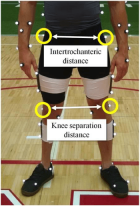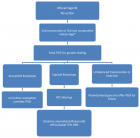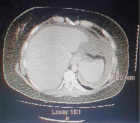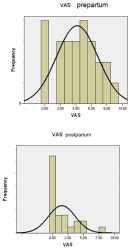Abstract
Research Article
3-Dimensional Versus 2-Dimensional Comparison of Knee Valgus Collapse during Vertical Jump: Clinical Implications for ACL Risk of Injury Assessment
Guilherme M Cesar*, Chase M Pfeifer and Judith M Burnfield
Published: 21 March, 2017 | Volume 2 - Issue 1 | Pages: 032-038
Time-efficient screening of lower extremity biomechanics to identify potential injurious movement patterns is crucial within athletic medicine settings. When considering biomechanical risk factors for anterior cruciate ligament injuries, several screening tests have been used to assess dynamic knee valgus. Current methods involving 3-dimensional motion capture systems are considered gold standard for such assessment; however, these methods are time consuming and require expensive materials. This study investigated the use of 2-dimentional kinematic evaluation during a standardized vertical jump athletic assessment to screen for potential lower extremity risk of injury. 50 collegiate athletes, 25 male and 25 female, from various sports participated in the study. The vertical jump was chosen because it is a common performance evaluation test that is regularly performed several times a year, providing consistent opportunities for screening while not creating additional obligations for the student athletes. Results showed that the 2-dimentional evaluation method had strong correlations (P<0.0001) with the gold standard 3-dimensional evaluation, suggesting that an accelerated 2-dimentional screening process can be used as a first step to screen for potential injurious lower extremity movement patterns.
Read Full Article HTML DOI: 10.29328/journal.jsmt.1001006 Cite this Article Read Full Article PDF
Keywords:
Injury risk assessment; Vertical jump; Motion analysis; Anterior cruciate ligament
References
- Chmielewski TL, Hodges MJ, Horodyski M, Bishop MD, Conrad BP, et al. Investigation of clinician agreement in evaluating movement quality during unilateral lower extremity functional tasks: a comparison of 2 rating methods. J Orthop Sports Phys Ther. 2007; 37: 122-129. Ref.: https://goo.gl/ZQcuQ5
- Ekegren CL, Miller WC, Celebrini RG, Eng JJ, Macintyre DL. Reliability and validity of observational risk screening in evaluating dynamic knee valgus. J Orthop Sports Phys Ther. 2009; 39: 665-674. Ref.: https://goo.gl/MWVea5
- Noyes FR, Barber-Westin SD, Fleckenstein C, Walsh C, West J. The drop-jump screening test: difference in lower limb control by gender and effect of neuromuscular training in female athletes. Am J Sports Med. 2005; 33: 197-207. Ref.: https://goo.gl/ADHyC7
- Barber-Westin SD, Noyes FR, Galloway M. Jump-land characteristics and muscle strength development in young athletes: a gender comparison of 1140 athletes 9 to 17 years of age. Am J Sports Med. 2006; 34: 375-384. Ref.: https://goo.gl/WbSn9Y
- McLean SG, Walker K, Ford KR, Myer GD, Hewett TE, et al. Evaluation of a two dimensional analysis method as a screening and evaluation tool for anterior cruciate ligament injury. Br J Sports Med. 2005; 39: 355-362. Ref.: https://goo.gl/Tzuzpz
- Sigward SM, Havens KL, Powers CM. Knee separation distance and lower extremity kinematics during a drop land: implications for clinical screening. J Athl Train. 2011; 46: 471-475. Ref.: https://goo.gl/aFS7TZ
- Sigward SM, Cesar GM, Havens KL. Predictors of Frontal Plane Knee Moments during Side-Step Cutting to 45 and 110 Degrees in Men and Women: Implications for Anterior Cruciate Ligament Injury. Clin J Sport Med. 2015; 25: 529-534. Ref.: https://goo.gl/YoYW4C
- Stearns KM, Powers CM. Improvements in hip muscle performance result in increased use of the hip extensors and abductors during a landing task. Am J Sports Med. 2014; 42: 602-609. Ref.: https://goo.gl/UoGzgB
- Pollard CD, Sigward SM, Powers CM. Limited hip and knee flexion during landing is associated with increased frontal plane knee motion and moments. Clin Biomech (Bristol, Avon). 2010; 25: 142-146. Ref.: https://goo.gl/aM3HUU
- Cesar GM, Pereira VS, Santiago PR, Benze BG, da Costa PH, et al. Variations in dynamic knee valgus and gluteus medius onset timing in non-athletic females related to hormonal changes during the menstrual cycle. Knee. 2011; 18: 224-230. Ref.: https://goo.gl/s7seq6
- Cesar GM, Tomasevicz CL, Burnfield JM. Frontal plane comparison between drop jump and vertical jump: implications for the assessment of ACL risk of injury. Sports Biomech. 2016; 15: 440-449. Ref.: https://goo.gl/Cf8ARl
- Nesser TW, Lee WL. The relationship between core strength and performance in division I female soccer players. Journal of Exercise Physiology Online. 2009; 12: 21-28. Ref.: https://goo.gl/1sDxha
- Robbins DW, Goodale TL, Kuzmits FE, Adams AJ. Changes in the athletic profile of elite college American football players. J Strength Cond Res. 2013; 27: 861-874. Ref.: https://goo.gl/Nazo4K
- Keller RA, Mehran N, Austin W, Marshall NE, Bastin K, et al. Athletic Performance at the NFL Scouting Combine After Anterior Cruciate Ligament Reconstruction. Am J Sports Med. 2015; 43: 3022-3026. Ref.: https://goo.gl/NAlTnh
- Bell DR, Oates DC, Clark MA, Padua DA. Two- and 3-dimensional knee valgus are reduced after an exercise intervention in young adults with demonstrable valgus during squatting. J Athl Train. 2013; 48: 442-449. Ref.: https://goo.gl/UmlJDq
- Chappell JD, Yu B, Kirkendall DT, Garrett WE. A comparison of knee kinetics between male and female recreational athletes in stop-jump tasks. Am J Sports Med. 2002; 30: 261-267. Ref.: https://goo.gl/8qt2um
- Bendjaballah MZ, Shirazi-Adl A, Zukor DJ. Finite element analysis of human knee joint in varus-valgus. Clin Biomech. 1997; 12: 139-148. Ref.: https://goo.gl/R5Z6Ws
- Markolf KL, Burchfield DM, Shapiro MM, Shepard MF, Finerman GA, et al. Combined knee loading states that generate high anterior cruciate ligament forces. J Orthop Res. 1995; 13: 930-935. Ref.: https://goo.gl/dXAEwU
- Ford KR, GD Myer, TE Hewett. Valgus knee motion during landing in high school female and male basketball players. Med Sci Sports Exerc. 2003; 35: 1745-1750. Ref.: https://goo.gl/WYqg5Y
- Grood ES, WJ Suntay. A joint coordinate system for the clinical description of three-dimensional motions: Application to the knee. Journal of Biomechanical Engineering. 1983; 105: 136–144. Ref.: https://goo.gl/f7Pe1f
- Evans JD. Straightforward statistics for the behavioral sciences. Pacific Grove, CA, Brooks/Cole Publishing.1996; Ref.: https://goo.gl/a6j39l
- Mizner RL, Chmielewski TL, Toepke JJ, Tofte KB. Comparison of 2-dimensional measurement techniques for predicting knee angle and moment during a drop vertical jump. Clin J Sport Med. 2012; 22: 221-227. Ref.: https://goo.gl/9sOsJh
Figures:

Figure 1

Figure 2

Figure 3
Similar Articles
-
3-Dimensional Versus 2-Dimensional Comparison of Knee Valgus Collapse during Vertical Jump: Clinical Implications for ACL Risk of Injury AssessmentGuilherme M Cesar*,Chase M Pfeifer,Judith M Burnfield. 3-Dimensional Versus 2-Dimensional Comparison of Knee Valgus Collapse during Vertical Jump: Clinical Implications for ACL Risk of Injury Assessment. . 2017 doi: 10.29328/journal.jsmt.1001006; 2: 032-038
-
The role of UK national ligament registry as additional source of evidence for anterior cruciate ligament reconstruction: Review of the literature and future PerspectivesTarek Boutefnouchet*,Thomas Laios,Keshav Mathur. The role of UK national ligament registry as additional source of evidence for anterior cruciate ligament reconstruction: Review of the literature and future Perspectives. . 2017 doi: 10.29328/journal.jsmt.1001012; 2: 081-090
-
Difference in Injury Risk between Male and Female Alpine Skiers: Review of the LiteratureBrittany Ammerman*, Margot Richards, Ryann Davie, Natalie Pahapill, Karen Sutton. Difference in Injury Risk between Male and Female Alpine Skiers: Review of the Literature. . 2024 doi: 10.29328/journal.jsmt.1001075; 9: 011-014
Recently Viewed
-
FITT-CORRECT: Updated dynamic and evidence-based principle of exercise prescriptionShambhu P Adhikari*,Jarugool Tretriluxana,Rubee Dev,Emily Eglitis,Nistha Shrestha,Cheryl Kerfeld6. FITT-CORRECT: Updated dynamic and evidence-based principle of exercise prescription. J Nov Physiother Rehabil. 2021: doi: 10.29328/journal.jnpr.1001039; 5: 005-009
-
Unusual cause of parietal thoracic pain: A case reportMohamed Labied*,Hayat Lhajoui,Najwa Touil,Omar Kacimi,Nabil Chikhaoui . Unusual cause of parietal thoracic pain: A case report. Arch Case Rep. 2020: doi: 10.29328/journal.acr.1001040; 4: 046-047
-
Zn2+ Ions-Immune Virucidal activities for children and adults with preventions against 2019-nCoV and COVID-19 infectionTsuneo Ishida*. Zn2+ Ions-Immune Virucidal activities for children and adults with preventions against 2019-nCoV and COVID-19 infection. J Child Adult Vaccines Immunol. 2020: doi: 10.29328/journal.jcavi.1001006; 4: 006-014
-
Exophthalmos Revealing a Spheno Temporo Orbital MeningiomaHassina S*, Krichene MA, Hazil Z, Bekkar B, Hasnaoui I, Robbana L, Bardi S, Akkanour Y, Serghini L, Abdallah EL. Exophthalmos Revealing a Spheno Temporo Orbital Meningioma. Int J Clin Exp Ophthalmol. 2024: doi: 10.29328/journal.ijceo.1001055; 8: 001-003
-
Unveiling the Impostor: Pulmonary Embolism Presenting as Pneumonia: A Case Report and Literature ReviewSaahil Kumar,Karuna Sree Alwa*,Mahesh Babu Vemuri,Anumola Gandhi Ganesh Gupta,Nuthan Vallapudasu,Sunitha Geddada. Unveiling the Impostor: Pulmonary Embolism Presenting as Pneumonia: A Case Report and Literature Review. J Pulmonol Respir Res. 2025: doi: 10.29328/journal.jprr.1001065; 9: 001-005
Most Viewed
-
Evaluation of Biostimulants Based on Recovered Protein Hydrolysates from Animal By-products as Plant Growth EnhancersH Pérez-Aguilar*, M Lacruz-Asaro, F Arán-Ais. Evaluation of Biostimulants Based on Recovered Protein Hydrolysates from Animal By-products as Plant Growth Enhancers. J Plant Sci Phytopathol. 2023 doi: 10.29328/journal.jpsp.1001104; 7: 042-047
-
Sinonasal Myxoma Extending into the Orbit in a 4-Year Old: A Case PresentationJulian A Purrinos*, Ramzi Younis. Sinonasal Myxoma Extending into the Orbit in a 4-Year Old: A Case Presentation. Arch Case Rep. 2024 doi: 10.29328/journal.acr.1001099; 8: 075-077
-
Feasibility study of magnetic sensing for detecting single-neuron action potentialsDenis Tonini,Kai Wu,Renata Saha,Jian-Ping Wang*. Feasibility study of magnetic sensing for detecting single-neuron action potentials. Ann Biomed Sci Eng. 2022 doi: 10.29328/journal.abse.1001018; 6: 019-029
-
Physical activity can change the physiological and psychological circumstances during COVID-19 pandemic: A narrative reviewKhashayar Maroufi*. Physical activity can change the physiological and psychological circumstances during COVID-19 pandemic: A narrative review. J Sports Med Ther. 2021 doi: 10.29328/journal.jsmt.1001051; 6: 001-007
-
Pediatric Dysgerminoma: Unveiling a Rare Ovarian TumorFaten Limaiem*, Khalil Saffar, Ahmed Halouani. Pediatric Dysgerminoma: Unveiling a Rare Ovarian Tumor. Arch Case Rep. 2024 doi: 10.29328/journal.acr.1001087; 8: 010-013

HSPI: We're glad you're here. Please click "create a new Query" if you are a new visitor to our website and need further information from us.
If you are already a member of our network and need to keep track of any developments regarding a question you have already submitted, click "take me to my Query."























































































































































